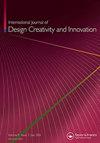神经认知反馈:在设计头脑风暴期间维持创意产生的前瞻性方法
IF 2.5
Q4 ENGINEERING, MANUFACTURING
International Journal of Design Creativity and Innovation
Pub Date : 2021-09-07
DOI:10.1080/21650349.2021.1976678
引用次数: 1
摘要
构思是工程设计的关键阶段,头脑风暴是一种成熟的构思方法。头脑风暴过程的一个限制是,想法产生往往在开始时达到顶峰,然后随着时间的推移迅速减少。在这项探索性研究中,我们测试了一种创新技术,通过向设计师提供有关他们神经认知的反馈来维持创意。我们使用神经成像技术(fNIRS)来监测学生在头脑风暴任务中的神经认知激活。一半的人收到了关于他们前额叶皮层神经认知活动的实时反馈,前额叶皮层是大脑中与工作记忆和认知灵活性相关的区域。接受神经认知反馈的学生保持更高的皮层激活和更长的持续峰值激活。与没有接受神经认知反馈的学生相比,接受神经认知反馈的学生表现出更高比例的右半球优势,这是一个与创造性处理相关的区域。右半球优势的增加与概念生成过程中解决方案数量的增加和更高的设计想法流畅性呈正相关。这些结果表明,在头脑风暴过程中,神经认知反馈可以维持产生想法所必需的认知激活。未来的研究应该探索神经认知反馈对设计师的影响,并将神经认知反馈与其他类型的干预进行比较,以维持创意。本文章由计算机程序翻译,如有差异,请以英文原文为准。
Neurocognitive feedback: a prospective approach to sustain idea generation during design brainstorming
ABSTRACT Ideation is a key phase in engineering design and brainstorming is an established method for ideation. A limitation of the brainstorming process is idea production tends to peak at the beginning and quickly decreases with time. In this exploratory study, we tested an innovative technique to sustain ideation by providing designers feedback about their neurocognition. We used a neuroimaging technique (fNIRS) to monitor students’ neurocognitive activations during a brainstorming task. Half received real-time feedback about their neurocognitive activation in their prefrontal cortex, a brain region associated with working memory and cognitive flexibility. Students who received the neurocognitive feedback maintained higher cortical activation and longer sustained peak activation. Students receiving the neurocognitive feedback demonstrated a higher percentage of right-hemispheric dominance, a region associated to creative processing, compared to the students without neurocognitive feedback. The increase in right-hemispheric dominance positively correlated with an increase in the number of solutions during concept generation and a higher design idea fluency. These results demonstrate the prospective use of neurocognitive feedback to sustain the cognitive activations necessary for idea generation during brainstorming. Future research should explore the effect of neurocognitive feedback with a more robust sample of designers and compare neurocognitive feedback with other types of interventions to sustain ideation.
求助全文
通过发布文献求助,成功后即可免费获取论文全文。
去求助
来源期刊

International Journal of Design Creativity and Innovation
ENGINEERING, MANUFACTURING-
CiteScore
3.80
自引率
27.80%
发文量
15
期刊介绍:
The International Journal of Design Creativity and Innovation is an international publication that provides a forum for discussing the nature and potential of creativity and innovation in design from both theoretical and practical perspectives. Design creativity and innovation is truly an interdisciplinary academic research field that will interest and stimulate researchers of engineering design, industrial design, architecture, art, and similar areas. The journal aims to not only promote existing research disciplines but also pioneer a new one that lies in the intermediate area between the domains of systems engineering, information technology, computer science, social science, artificial intelligence, cognitive science, psychology, philosophy, linguistics, and related fields. The journal covers, but is not restricted to, the following topics: ·Theories on Design Creativity and Innovation ·Cognition of Design Creativity ·Innovative Process ·Inventive Process ·Analogical Reasoning for Design Creativity and Innovation ·Design Synthesis ·Method and Tools for Design Creativity and Innovation ·Representation of Design Creativity and Innovation ·Education for Design Creativity and Innovation ·Concept Generation and Inspiration.
 求助内容:
求助内容: 应助结果提醒方式:
应助结果提醒方式:


